last update: Nov 19, 2019
Research Directions
[top]
Integrability and Quantum Macroscopic Coherence
Creating a Quantum Coherent State of the Relative Distance between Two Solitons in a Breather
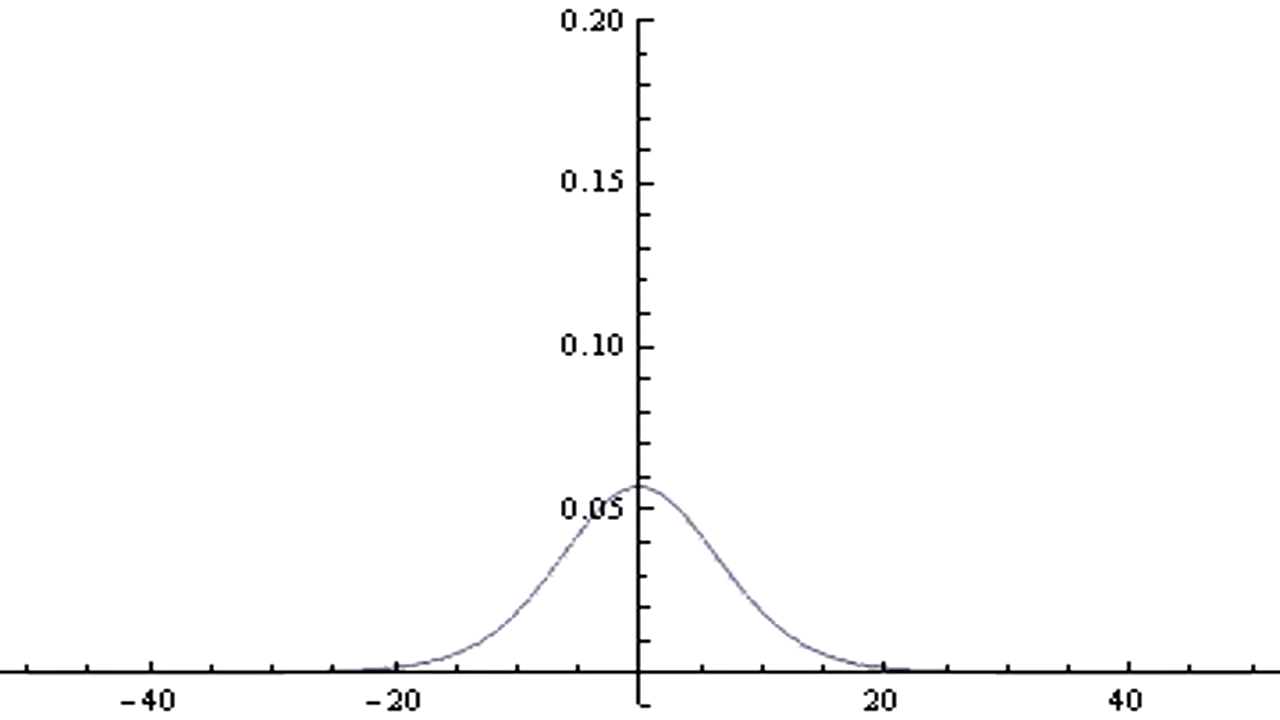 We are exploring a possibility for a creation of a coherent quantum state of
the macroscopic degrees of freedom of BEC solitons. In particular, we showed that
in a quench from a single soliton to a breather (a bi-soliton), the relative coordinate
of the two constituent daughter solitons is emerges cold and coherent, regardless of how
hot the center of mass of the mother soliton
was[YMHOA17].
We are exploring a possibility for a creation of a coherent quantum state of
the macroscopic degrees of freedom of BEC solitons. In particular, we showed that
in a quench from a single soliton to a breather (a bi-soliton), the relative coordinate
of the two constituent daughter solitons is emerges cold and coherent, regardless of how
hot the center of mass of the mother soliton
was[YMHOA17].
Creation of a breather in realistic conditions is optimized
in[GRDMOD18].
The quatum-fluctuation-induced spatial separation of the constituent solitons can be accelerated
using repulsive
barriers[MMYODH19].
The underlying integrability can be shown to remain intact for a wide range of
parameters[DO15].
Interferometry with the Center-of-Mass of a Quantum Solitons
We are investigating the ways of protecting the center of mass state of
single solitons: in particular, adding a lattice enforces an energy gap between the
solitonic ground state and its
excitations[NGMMOA18].
We demonstrate numerically that for the same interferometer geometry, the absolute lower bound for
a detectable angular velocity decreases N-fold when the individual atoms are
lumped into a single
soliton[NGDPOAM19].
Scale Invariance and Quantum Anomalies
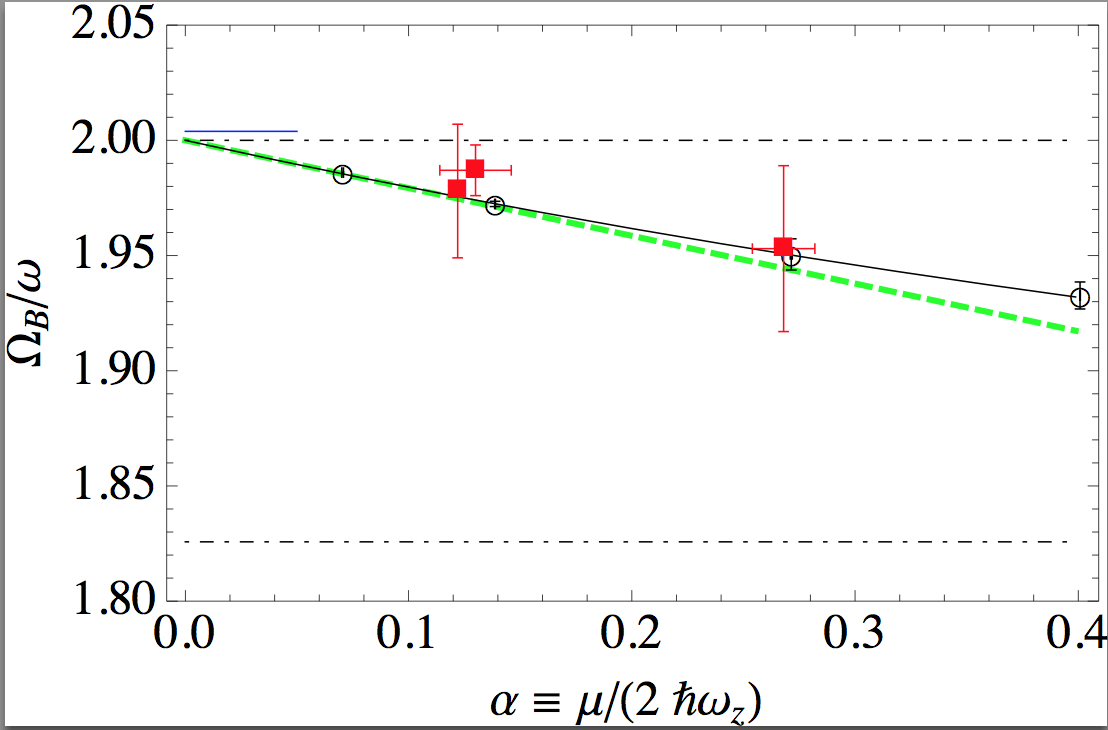
We are interested in the rare examples of systems with no length scales and in the consequences of weak breaking of this property. One of the most
prominent properties of scale-free gases is the monochromaticity of the breathing excitations: their frequency is strictly fixed to be the double of the trapping
frequency, for any amplitude. In the case of two-dimensional Bose gases, the departure from this law may occur due to
quantum effects (the so-called quantum
anomaly)[OPL10],
and due to the weak residual interaction with the third
dimension[MDL13]
(see the results of our experimental-theoretical study on the left).
Similar results are obtained for one-dimensional p-wave-interacting fermions, and for bosons near the Tonks-Girardeau regime
[CDZO15]
[ZAA14].
The quantum anomaly predicted in [OPL10] has been
recently observed experimentally [Murthy et al, arXiv:1805.04734; Peppler et al, arXiv:1804.05102].
Bethe Ansatz
Integrable Many-Body Systems and Platonic Solids
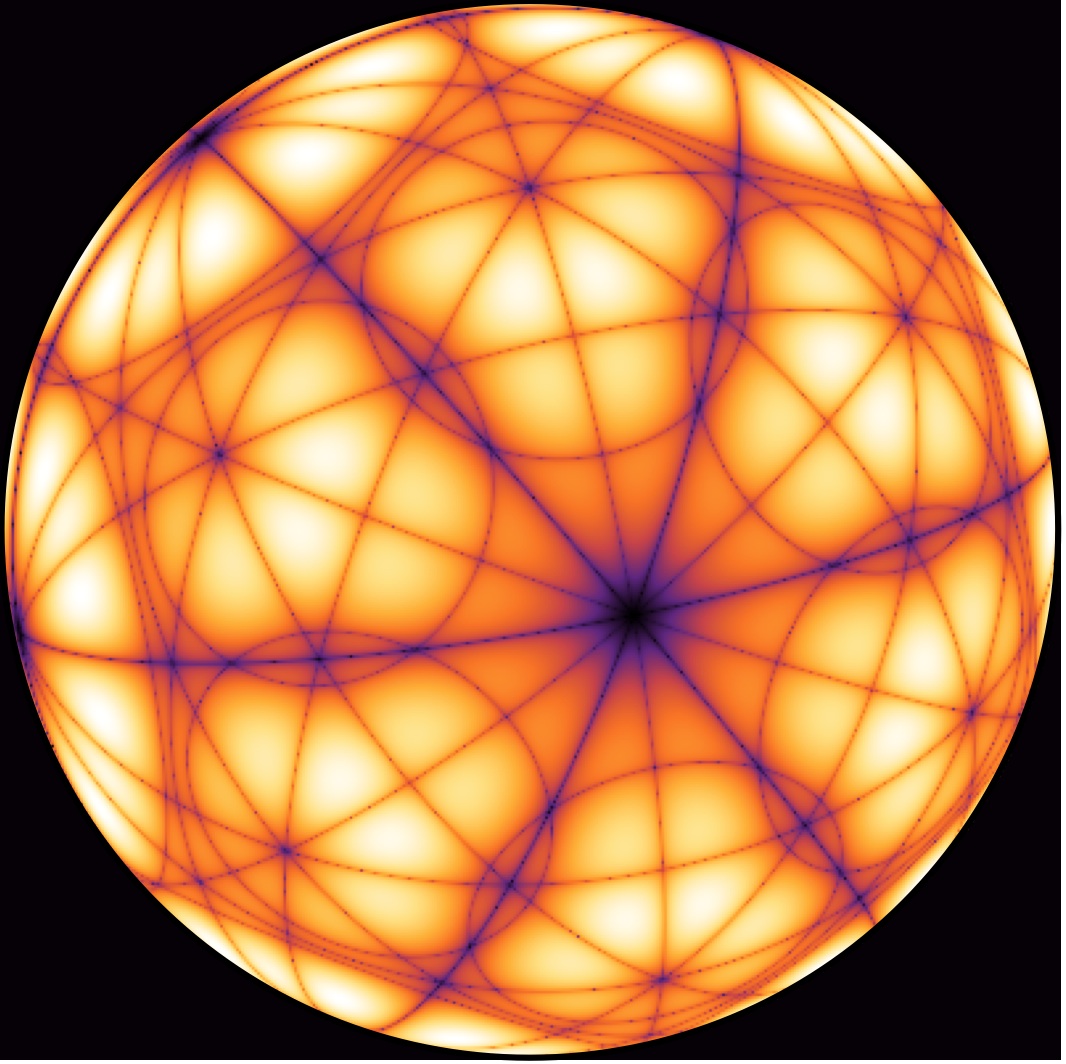
Since the mid-70's, it has been believed that there exist only two types of reflection groups that can generate
exact solutions to quantum N-body problems with short-range interactions: AN-1 and CN.
These, respectively, allow one to solve the problem of an ensemble of atoms of identical masses on a ring, and in a box.
We show[JO15],
however,
that the eigenenergies and eigenstates of a system consisting of four one-dimensional hard-core particles with masses
6m, 2m, m, and 3m in a hard-wall box can be found exactly using the Bethe ansatz based on the reflection group F4.
The latter is associated with the symmetries and tiling properties of an octacube
 : a Platonic solid unique to four dimensions, with no three-dimensional analogues.
A particular section of the ground state wavefunction is shown on the left.
: a Platonic solid unique to four dimensions, with no three-dimensional analogues.
A particular section of the ground state wavefunction is shown on the left.
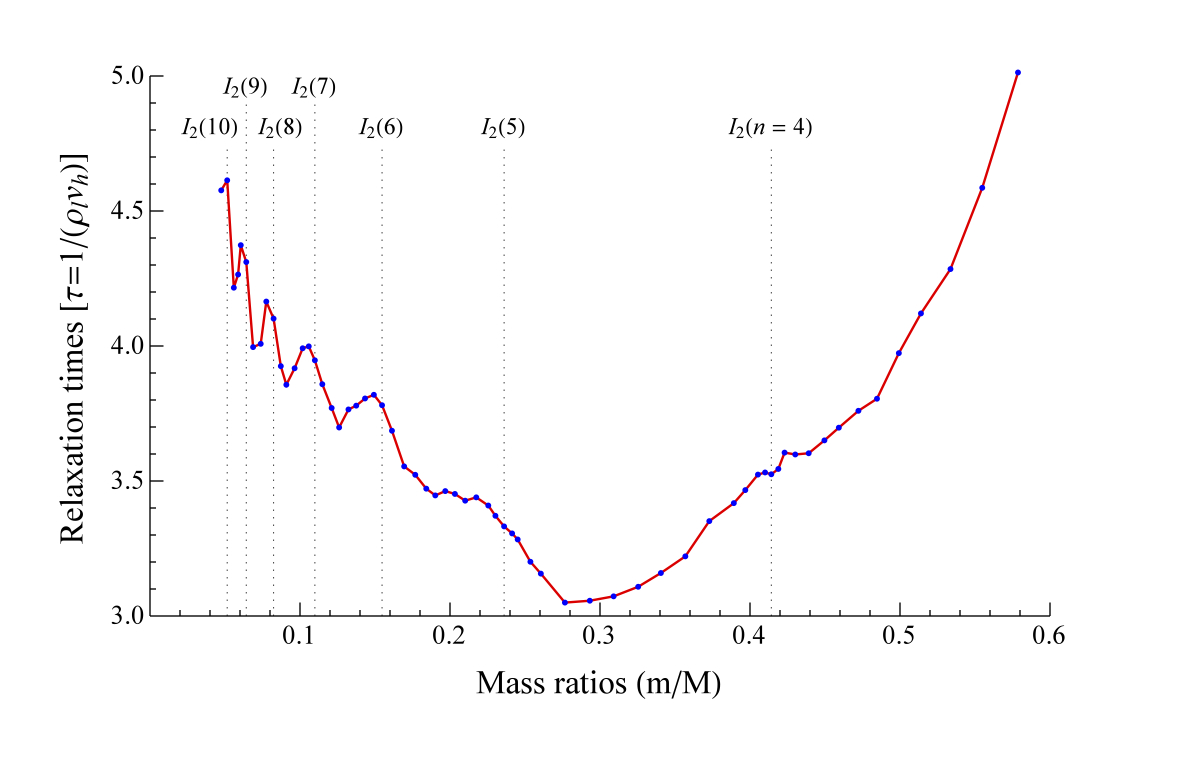
Recently, we extended the above method to non-crystallographic reflection groups, to the symmetries of the
3D and 4D icosahedra (H3 and H4) in particular[SSJO16].
We invoke the reflection groups of regular polygons  , I2(n), to predict and confim
numerically[HCO15] (see also [AGHJOA17])
the distinct peaks in the dependence of the relaxation time on the mass ratio in a one-dimensional mixture of atoms of two different masses, with hard-core interactions [figure to the right].
, I2(n), to predict and confim
numerically[HCO15] (see also [AGHJOA17])
the distinct peaks in the dependence of the relaxation time on the mass ratio in a one-dimensional mixture of atoms of two different masses, with hard-core interactions [figure to the right].
Harmonically trapped atoms lead to spherical billiards. Similarly to the relative motion of N particles on a line,
integrability of N atoms in a harmonic potential is governed by the finite N-1-dimensional
reflection groups; in particular, the integrable
mass spectra are identical for these two models. We study explicitly the four-body integrability instances, given
by the tetrahedral, cubic/octahedral, and dodecahedral/icosahedral symmetries,
A3, C3, and H3 respectively, and in the case of H3,
demonstrate numerically a transition from a Wigner-Dyson to Poisson
statistics for an H3 mass ratio set[HODVJZ17].
Of a particular interest is the ability of integrable systems to stir the quantum evolution towards
entangled states. We study this effect in the context of a so-called Galilean Cannon, in turn related
to the symmetries of the N-dimensional tetrahedra, AN. In an interferometric
scheme we
suggest[OSDJ16], a light particle
is beam-split and then, subsequently entangled with a heavy component of the system that never sees a
beamsplitter. This scheme, if used as a sensor, shows an (Natoms)1/2
increase in sensitivity as compared to the conventional scheme, for the same total
number of atoms Natoms.
Other Bethe-Ansatz-based Projects
We study in detail a Calogero-Sutherland model with screening[PBOC17]. We find that an introduction of a radius r
screening (cut-off of interactions
between two atoms when the latter are separated by more than r-1 other atoms) does not affect the integrability
of the system, and,
as in the un-screened case, the spectrum is controlled by the AN-1 reflection group, for N atoms.
We revisit correlations in the Lieb-Liniger model (δ-interacting bosons on a ring)
and find a connection between the local three-body correlation
function and the forth derivative of the one-body
correlator[ODML17].
In the problem of scattering of a bosonic dimer on a barrier, we find that while the whole problem
is not Bethe Ansatz integrable, it shares a part of its Hilbert space with an integrable
problem associated with the C2 reflection
group[GMO19].
As a result, the dimer dissociation becomes prohibited for spatially odd incident states. We suggest
using this effect to effectuate a spatially compact readout off a chip-based atom interferometer.
We realized that under a stereographic projection, finite four-dimensional reflection groups
induce three-dimensional finite groups of sphere inversions. This allows one to
generate 19 3-parametric families of solvable electrostatic
problems[OSYDJ19].
Soliton Theory
Scattering without Reflection, QM-SUSY, and the Inverse Scattering Transform
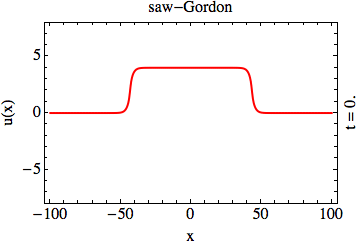
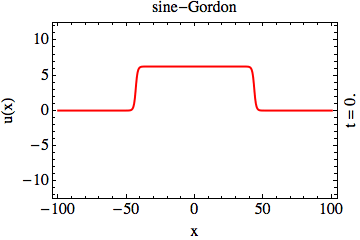
In the context of solitons in integrable partial differential equations, transparent potentials emerge in two unrelated instances:
first, as the Lax operators (whose eigenvalues are the integrals of motion of the PDE in question); and second, as the Bogoliubov-de-Genes (BdG) Hamiltonians
(emerging from the linearization of the PDE). Transparent potentials, Lax operators, and BdG Hamiltonians form an entagled web the
structure of which is yet to be understood.
While the transparency of the solitonic Lax operators is well understood, the similar assertion about solitonic BdG Hamiltonians is far
from obvious. To this end, we show that the transparency of the BdG Hamiltonian is in fact a necessary condition that ensures the mutual
transparency of the solitons (the sine-Gordon animation, above); the appearance of the reflection of waves in the BdG problem leads to a mutual
destruction of the solitary waves upon collision (the “saw”-Gordon animation, above) [KHO15].
The transparency of both the Lax and the BdG Liouvillians can be analyzed using the methods of the quantum-mechanical supersymmetry (QM-SUSY)
[KO11]
[KHO15]
We found that when one applies a nonintegrable perturbation to an integrable PDE, the notion of the “strength” of the perturbation
depends dramatically on whether one works with the original equation or recasts the dynamics in Lax terms. For example, dramatic changes in the velocity of solitons can become small effects in the
Lax formalism. We see this when we study the scattering of a two-soliton (a nonlinear superposition of two simple solitons that is itself an exact solution of the PDE) off a barrier. In the Lax context, the soliton velocity is a small real part of a complex number whose imaginary part, given by soliton's weight, is much larger in magnitude and, therefore, only negligibly changed in the process
[DO15].
Two- and three-dimensional BEC solitons
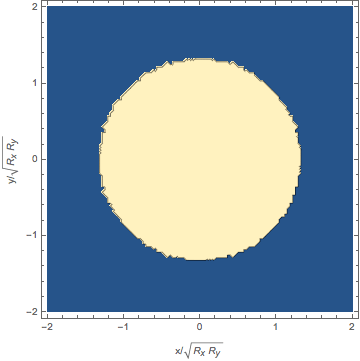
We addressed the question of stabilization of the three-dimensional bosonic solitary waves. To this end, we suggest
altering the atomic disperion from quadratic to quartic using shaken optical lattice. We show that
quartic dispersion is strong enough to support 3D solitary waves of arbitrary size and unlimited mobility
[OCD15].
Quantum Nonequilibrium, Atomtronics
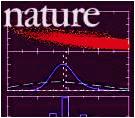
This reserch direction is devoted to the study of quantum nonequilibrium states and their applications in atomtronics. We began by suggesting a simple
way of incorporating nontrivial conserved quantities in a thermodynamical description of a system
[RDYuO07].
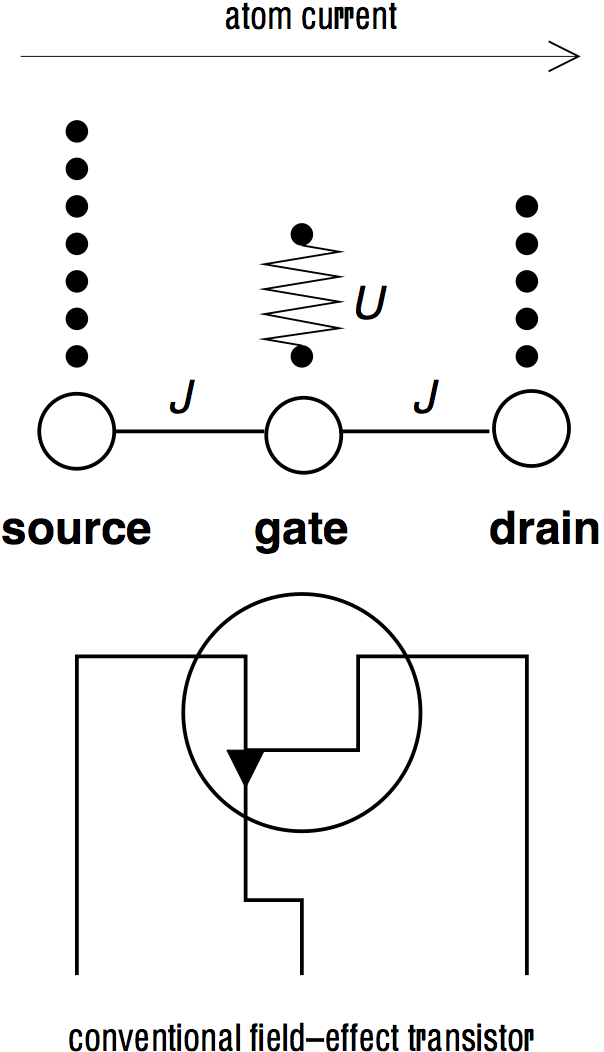 Next, we gave a straightforward numerical justification for the Eigenstate Thermalization Hypothesis, the cornerstone of the quantum nonequilibrium studies
[RDO08].
The memory of the initial conditions in various quantum systems has been studied in
[OJRD12]
[YuO11]
[SAYuO10].
The ultimate goal of this direction of research is to formulate a thermodynamical description that would universally apply to
mesoscopic and/or near-integrable quantum systems
[Ols15]
[SJD14]. The atom transitor (right), is the primary object of interest
[ZDO15].
Next, we gave a straightforward numerical justification for the Eigenstate Thermalization Hypothesis, the cornerstone of the quantum nonequilibrium studies
[RDO08].
The memory of the initial conditions in various quantum systems has been studied in
[OJRD12]
[YuO11]
[SAYuO10].
The ultimate goal of this direction of research is to formulate a thermodynamical description that would universally apply to
mesoscopic and/or near-integrable quantum systems
[Ols15]
[SJD14]. The atom transitor (right), is the primary object of interest
[ZDO15].
Marvin D. Girardeau (1930-2015)
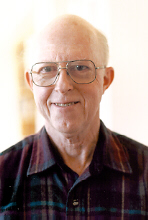
Marvin Girardeau, the closest colleague and a mentor, the creator
of the first ever exactly solvable quantum many-particle
system,
passed away on 13 January 2015. Obituary in Physics Today can
be
found here.
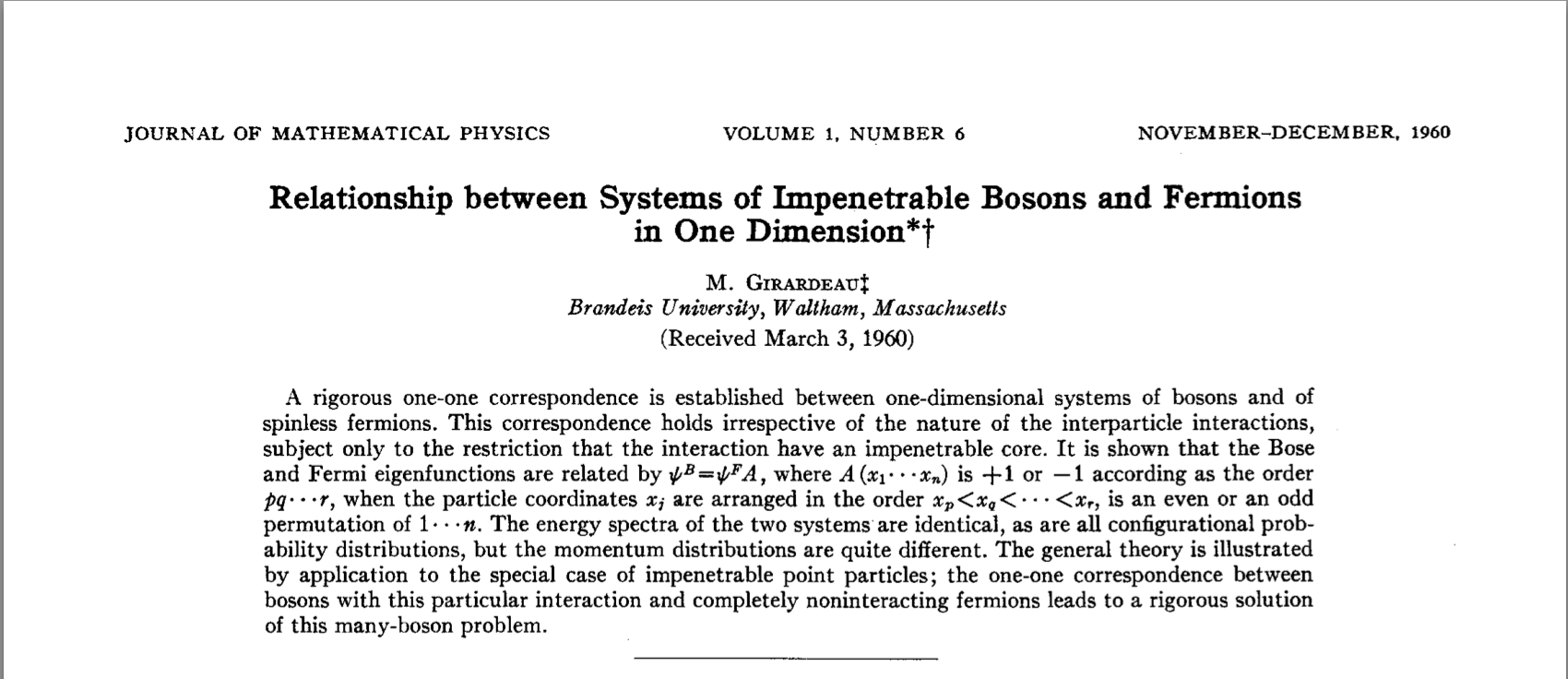
group
collaborators within UMB
external collaborators
-
Nathan Harshman, American U, USA

-
Hélène Perrin, U Paris Nord, France

-
Anna Minguzzi, U Grenoble, France

- Vladimir Yurovsky, Tel Aviv U, Israel

- Boris Malomed, Tel Aviv U, Israel

-
Randall Hulet, Rice U, USA

past members
- Jake Golde, MS 2017
- Joseph Seaward, MS 2017
- Thibault Scoquart, ENS intern, Spr 2016
- Zhedong Zhang, PhD 2016
- Stephen Choi, post-doc, 2014
- Frank Cao, MS 2013
- Andrew Koller, MS 2011 (see thesis )
- Yassine Ait El Aoud, MS 2012
- Cavan Stone, MS 2011
- Marcos Rigol, post-doc, 2006-2007
- Amy Cassidy, PhD 2009
- Douglas Mason, BS 2006
- Hieu Nguyen, BS 2005
Back-Of-The-Envelope Quantum Mechanics: With Extensions To Many-Body Systems And Integrable PDEs (World Scientific (2013))
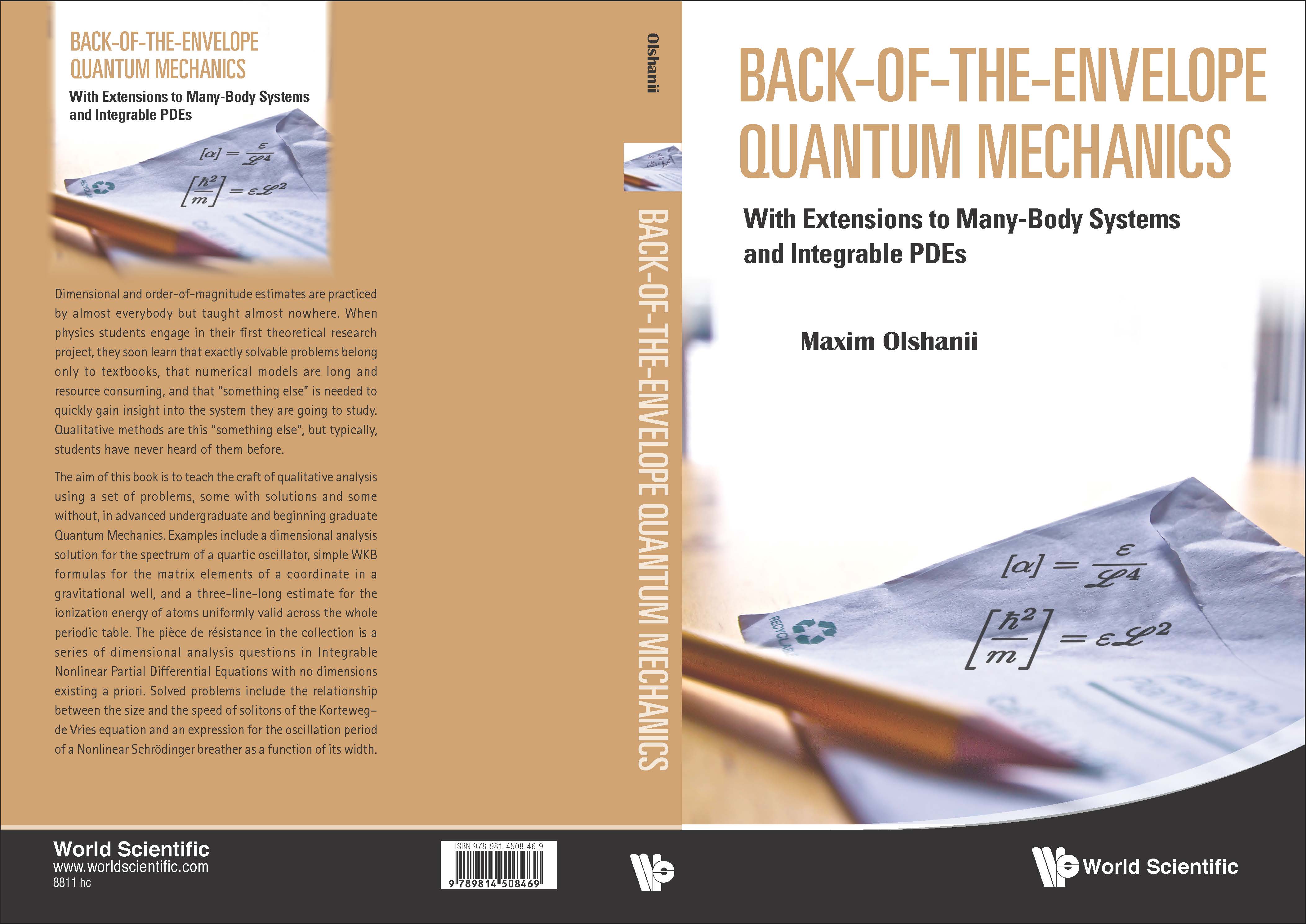
A Contemporary Physics review on this book can be found here.
Errata.
Our Group in Popular Press...
[top]
"The quantum steampunker by Massachusetts Bay," by Nicole Yunger Halpern, Quantum Frontiers, October 27, 2019
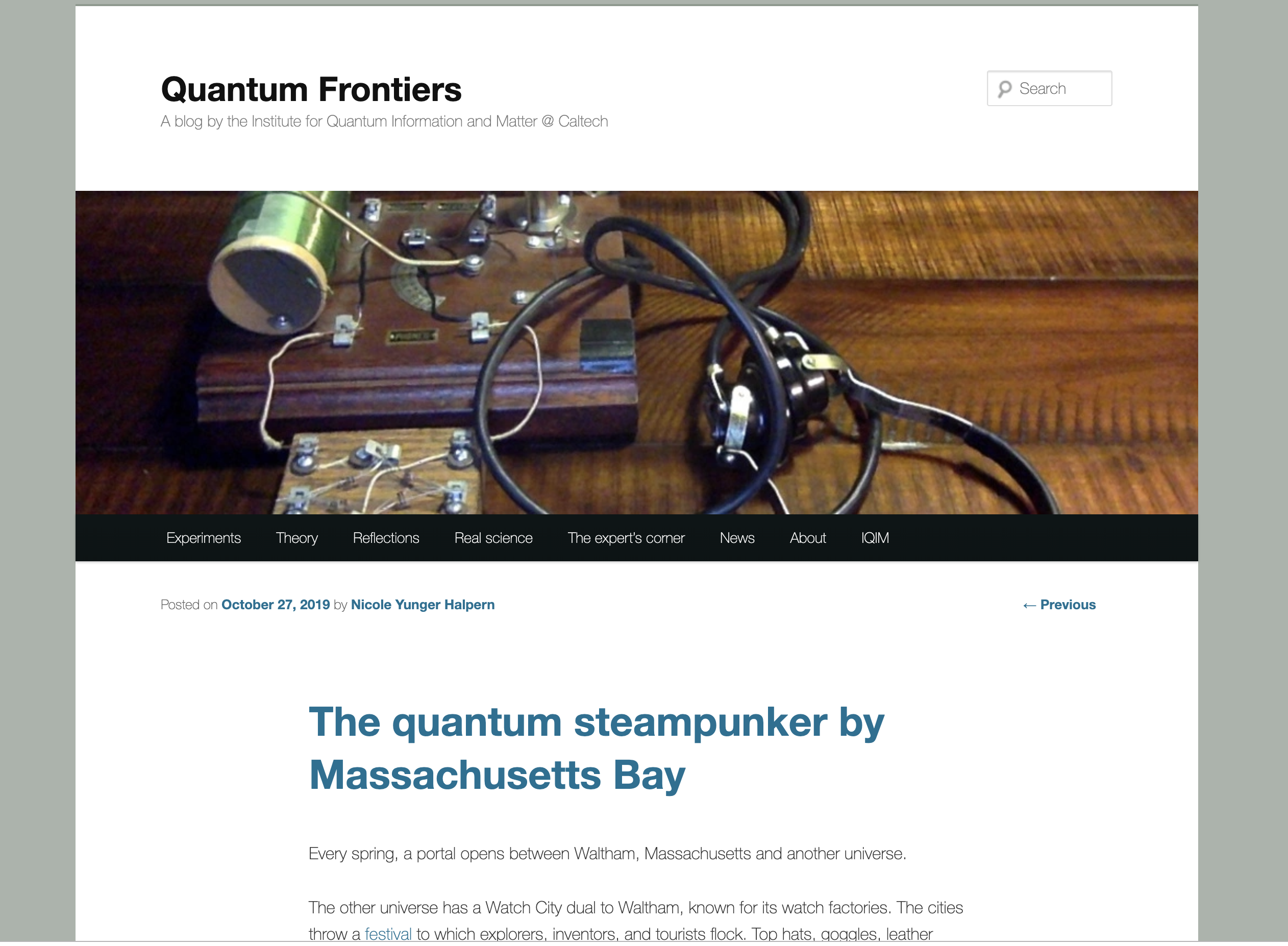
Generalized Gibbs Ensemble, Quantum Steampunk, diode bridges, and all that.
"Pop Science," by Roger Highfield, New Scientist, 29 October 2011

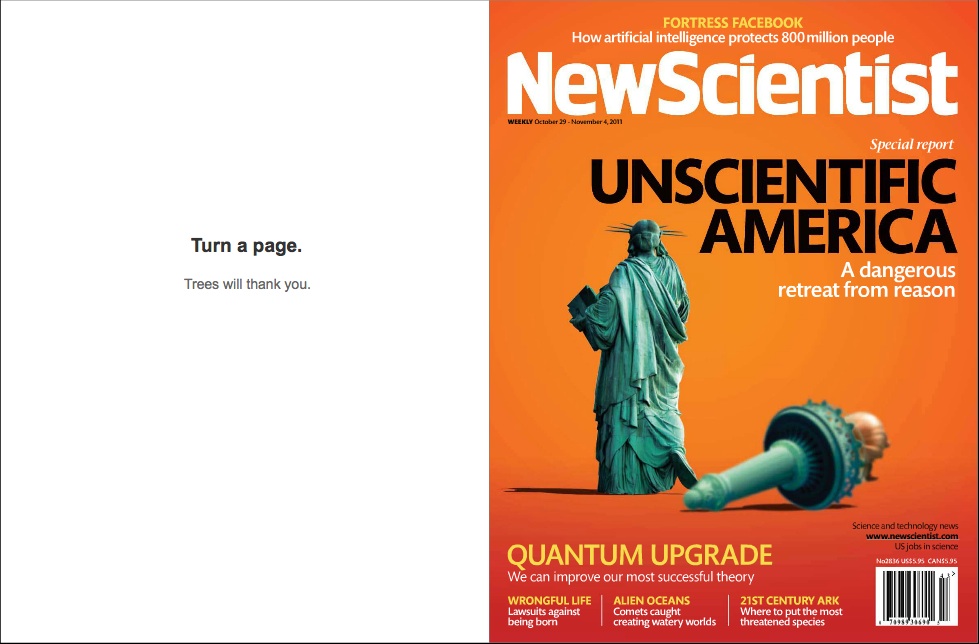
A popular report on various studies of explosions, both in science and in the arts.
Our Nature study is
presented as an example of research in the field of quantum explosions.
"Molecular surprise in one dimension," Physics World, June 9, 2005

A report on an experimental confirmation of the prediction of the existence of waveguide-confined molecules
for both attractive and repulsive interactions between constituent atoms.
...and in Arts
[top]
"Rhombic dodecahedron," Michel Serratrice, 2015

"Rhombic Dodecahedron," an artwork by Michel Serratrice,
was directly inspired by our musings on octacubes. The rhombic dodecahedron in 3D and the octacube
in 4D are members of a sequence of space-tiling d-dimensional solids obtained via the following
procedure: a d-dimensional cube is split into pyramids, 2d of them, with
its center as their common apex and its (d-1)-dimensional faces as their
respective bases; the pyramids
are then reflected about their bases, forming a new d-dimensional solid.
 We are exploring a possibility for a creation of a coherent quantum state of
the macroscopic degrees of freedom of BEC solitons. In particular, we showed that
in a quench from a single soliton to a breather (a bi-soliton), the relative coordinate
of the two constituent daughter solitons is emerges cold and coherent, regardless of how
hot the center of mass of the mother soliton
was[YMHOA17].
We are exploring a possibility for a creation of a coherent quantum state of
the macroscopic degrees of freedom of BEC solitons. In particular, we showed that
in a quench from a single soliton to a breather (a bi-soliton), the relative coordinate
of the two constituent daughter solitons is emerges cold and coherent, regardless of how
hot the center of mass of the mother soliton
was[YMHOA17].







 Next, we gave a straightforward numerical justification for the Eigenstate Thermalization Hypothesis, the cornerstone of the quantum nonequilibrium studies
Next, we gave a straightforward numerical justification for the Eigenstate Thermalization Hypothesis, the cornerstone of the quantum nonequilibrium studies







